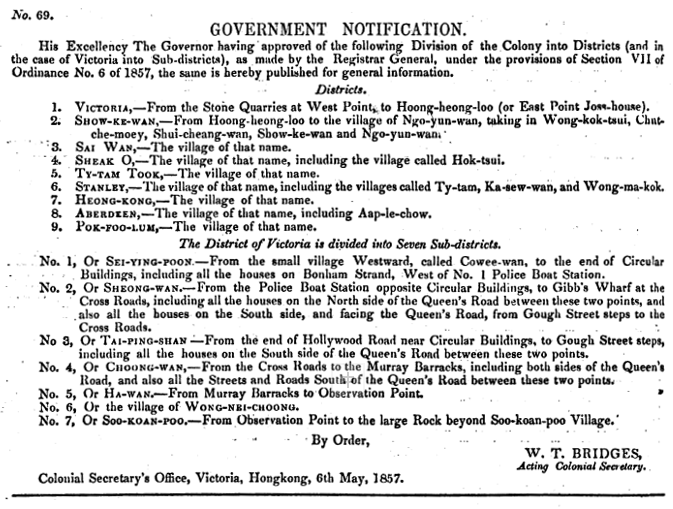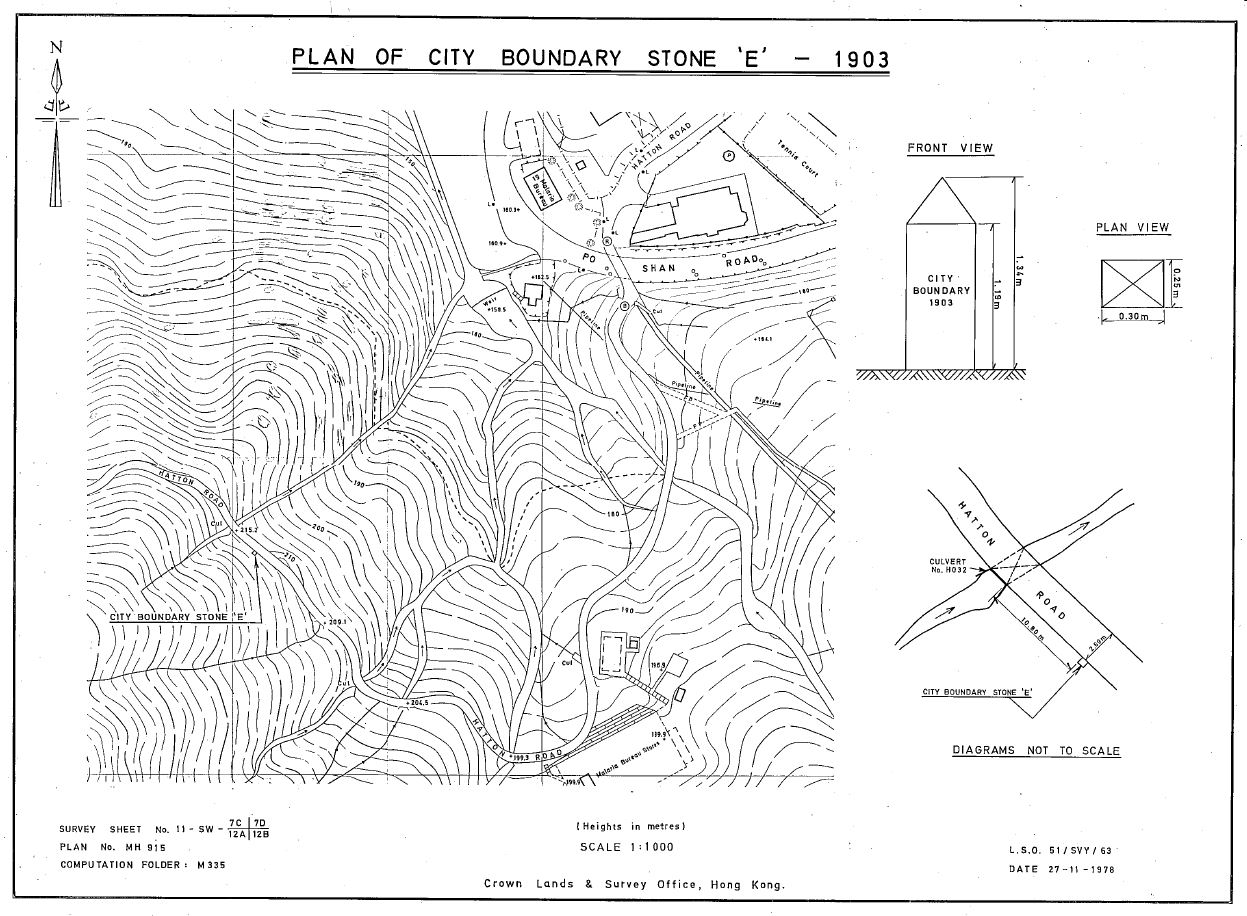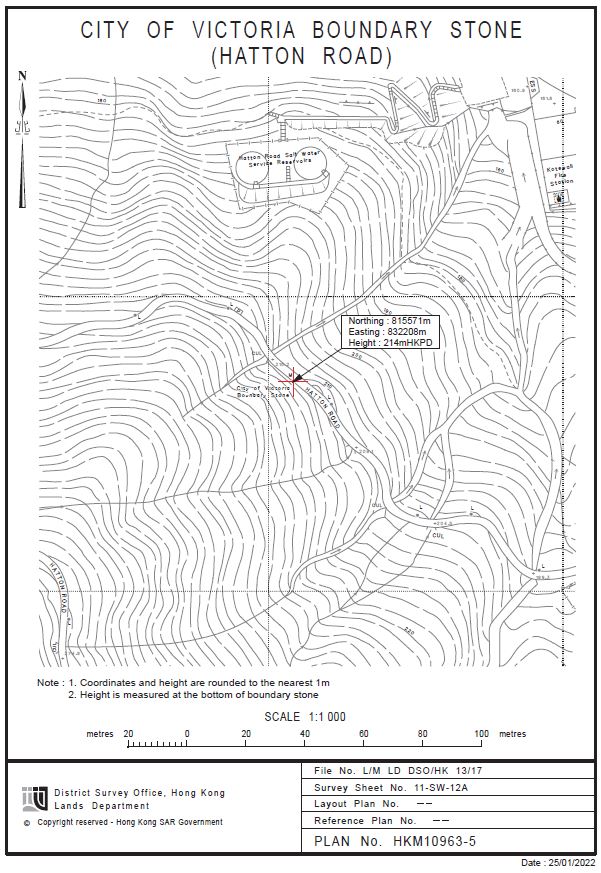City of Victoria Boundary Stones
Historical Background of the City of Victoria Boundary Stone 1903
City of Victoria
On 14 Jun 1841, the Hong Kong government held the first public auction for land sale. A total of 34 lots of land were sold, centered in Sheung Wan, Central and Wan Chai on the north shore of Hong Kong Island. It was called the "Queen's City" at the time and was connected by Queen's Road. On 29 Jun 1843, the former Hong Kong government officially named the city on the north shore of Hong Kong Island "Victoria City". "Victoria City" was adopted administratively as a "district" and were referred to in different reports and statutes such as the Market Ordinance (No. 9 of 1958), Rating Ordinance etc. On 9 May 1857, with the expansion of Victoria City, the Hong Kong government published the gazette and divided the Hong Kong Island into nine districts.
- Victoria
- Show Ke Wan
- Sai Wan
- Sheak O
- Ty Tam Took
- Stanley
- Heong Kong
- Aberdeen
- Pok Foo Lum

The district of Victoria was further divided into seven sub-districts.
- No. 1 Or Sei Ying Poon
- No. 2 Or Sheong Wan
- No. 3 Or Tai Ping Shan
- No. 4 Or Choong Wan
- No. 5 Or Ha Wan
- No. 6 Or Wong Nei Choong
- No. 7 Or So Koan Poo
Four Circuits and Nine Yeuks
Chinese Residents called the Victoria City area summarily as "Four Circuits and Nine Yeuks". "Circuit" refers to the landform of the north shore of Hong Kong Island, which is like a circle, while "Yeuks" refers to the beginning and end of the lot.Four Circuits included:
- Ha Wan, i.e. Lower Circuit (from Wanchai Road to Arsenal Street),
- Choong Wan, i.e. Central Circuit (from Murray Parade Ground to the junction of Wellington Street and Queen's Road Central),
- Sheung Wan, i.e. Upper Circuit (from the junction of Wellington Street and Queen's Road Central to Civil Hospital) and
- Sai Wan, i.e. Western Circuit (from Connaught Road West to Kennedy Town).
The Nine Yeuks were:
- The first Yeuk: from Kennedy Town to Shek Tong Tsui
- The second Yeuk: from Shek Tong Tsui to Sai Ying Pun
- The third Yeuk: Sai Ying Pun
- The fourth Yeuk: eastern half of Connaught Road West
- The fifth Yeuk: from Western Market to Central Market
- The sixth Yeuk: from Central Market to Arsenal Street
- The seventh Yeuk: from Arsenal Street to Wan Chai Road
- The eighth Yeuk: from Wan Chai Road to Bowrington Canal
- The ninth Yeuk: from Bowrington Canal to Causeway Bay
However, the Nine Yeuks in the "Four Circuits and Nine Yeuks" are not actually a fixed concept but have been revised many times and have multiple versions.
City of Victoria Boundaries 1903
Boundaries of the City of Victoria on Hong Kong Island were defined by “The City of Victoria Boundaries Ordinance 1903” on 20 November 1903.The 1903 description was later transferred to the Interpretation Clause Ordinance (No. 31 of 1911) with some amendments. With the changes of topographical details and the designations of the lots that were adjacent to the boundaries, the definition of the boundaries was revised in 1950 and 1966 in the Interpretation and General Clauses Ordinance (Cap. 1). The same descriptions of the boundaries since 1966 have been kept unchanged and remained in force in the ordinance. The boundaries were defined by pure descriptions without referring to a map.

Click Here to download from CSDI Portal
According to the current Chapter 1 Interpretation and General Clauses Ordinance of the Hong Kong Legislation, the definition of the Boundaries of the City of Victoria is as follows:
- On the north - The Harbour;
- On the west - A line running due north and south drawn through the north-west angle of Inland Lot No. 1299 and extending southwards a distance of 850 feet from the aforesaid angle;
- On the south - A line running due east from the southern extremity of the western boundary until it meets a contour in the vicinity of the Hill above Belchers 700 feet above principal datum, that is to say, a level 17.833 feet below the bench-mark known as “Rifleman’s Bolt”, the highest point of a copper bolt set horizontally in the east wall of the Royal Navy Office and Mess Block Naval Dockyard, and thence following the said contour until it meets the eastern boundary;
- On the east - A line following the west side of the Government Pier, Bay View and thence along the west side of Hing Fat Street, then along the north side of Causeway Road to Moreton Terrace. Thence along the west side of Moreton Terrace to the south-east corner of Inland Lot No. 1580 and produced in a straight line for 80 feet, and thence along the north side of Cotton Path and produced until it meets the west side of Wong Nei Chong Road on the east side of Wong Nei Chong Valley and thence to the south-east angle of Inland Lot No. 1364, produced until it meets the southern boundary.
City of Victoria Boundary Stone 1903
In 20 November 1903, the Hong Kong government published the boundaries of Victoria City in the Gazette and erected boundary stones by the then Public Works Department to mark the boundaries of the city. The fixing of boundary stones for the City of Victoria was reported intermittently in the 1924 and 1929 Annual Reports of the Director of Public Works. These granite boundary stones are obelisk-like protruding about 1.3 meter above ground with a cross-section of approximately 0.3 meter square. An inscription "City Boundary 1903" can be clearly seen on one side of the boundary stone.

| Location | Northing (m) | Easting (m) | Height (m above HKPD) |
|---|---|---|---|
| About 90 m from the junction of Broadwood Road Road, the intersection of the Wong Nai Chung Road and the eastern boundary of the City of Victoria. | 814915 | 836999 | 8 |
| About 330 m from the junction of Stubbs Road, the intersection of the Bowen Road and the eastern boundary of the City of Victoria. | 814140 | 836920 | 123 |
| On the northwest slope of Mount Nicholson, the intersection point of the eastern boundary of the City of Victoria and the 700 feet contour line. | 813758 | 836879 | 213 |
| About 50 m from the junction of Tregunter Path, the intersection of the Old Peak Road and the 700 feet contour line. | 815134 | 833693 | 216 |
| About 570 m from the junction of Conduit Road, the intersection of the Kotewall Road and the 700 feet contour line. | 815571 | 832208 | 214 |
| On the southwest slope of Lung Fu Shan, the intersection point of the southern boundary of the City of Victoria and the 700 feet contour line. | 815580 | 831901 | 212 |
| About 280 m from the junction of Pokfield Road, the intersection of the Pok Fu Lam Road and the southern boundary of the City of Victoria. | 815592 | 831567 | 97 |
| On the northwest slope of Mount Davis, the intersection point of the western and southern boundary of the City of Victoria. | 815584 | 830479 | 148 |
| Kennedy Town Temporary Recreation Ground, Sai Ning Street. (Moved to current location in 1978, originally situated at the northern end of the western boundary of the City of Victoria, where the current site is Serene Court.) |
815854 | 830472 | 4 |


Maintenance of the City of Victoria Boundary Stone
Registrar General (Land Officer) had advised in 1978 that since the city boundaries had been clearly defined by the Interpretation and General Clauses Ordinance, the boundary stones had no added legal significance and could merely be considered as a way of identifying the boundaries on the ground at the place where they were apparently located. The Antiques and Monument Office had put the boundary stones under the "Government Historic Sites Identified by AMO". The Survey and Mapping Office of Lands Department will continue to look after these stones in the days to come.
Reference
- Joseph S. P. Ting, Nai Kwan WONG (1994), City of Victoria: A Selection of the Museum’s Historical Photographs, Hong Kong Museum of History
- 香港史學會(2014)。《文物古蹟中的香港史 I》。香港:中華書局。
- 香港歷史研究社(2015)。《爐峰史研》。香港:自然探索學會。
- 蕭國健(2021)。《簡明香港近代史》。香港:三聯書店。
- 蕭國健(2022)。《石頭上的香港史》。香港:三聯書店。
- 馮邦彥(2022)。《香港城市掠影》。香港:中華書局。
- 施志明(2023) 。《條界任你擺》。香港:白卷出版有限公司。
- 綠洲 Oasistrek (2021) 。《維多利亞城界石》檢自:https://www.oasistrek.com/city_of_victoria.php
- 維基百科Wikipedia (2023) 。《維多利亞城界碑》檢自:https://zh.wikipedia.org/wiki/維多利亞城界碑

